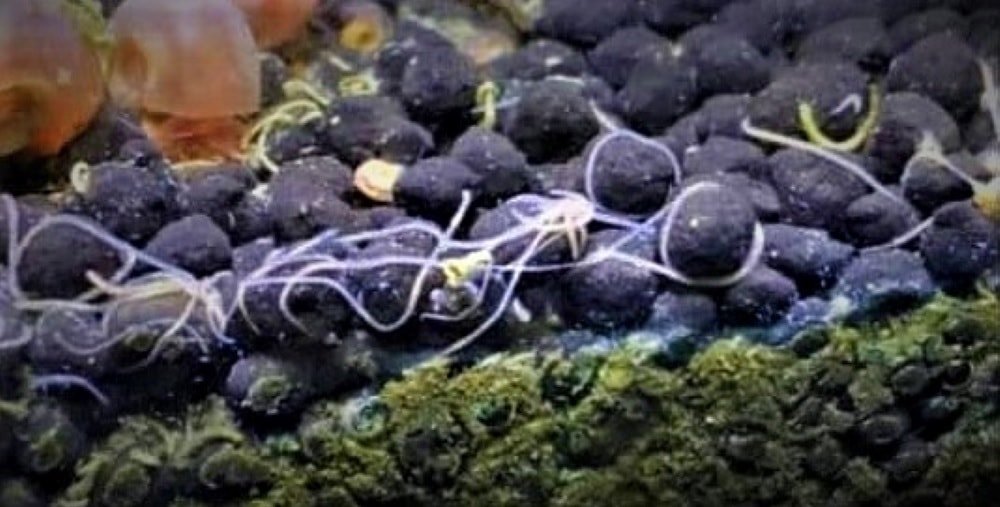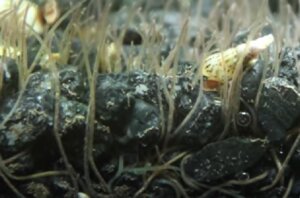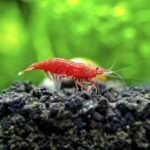What Are Detritus Worms?
Detritus worms are small aquarium pests that tend to be overlooked. They are any type of worm or larvae present in the organic matter in aquariums, the vast majority being an (for reference, earthworms, leeches, and bed worms are also annelids.
In ideal aquarium conditions, the worm population remains low or nearly non-existent. When the level of organic matter in the aquarium is controlled and there is regular maintenance, the environment does not allow for large-scale development of these worms.
However, when aquariums are neglected and organic matter reaches high levels, high worm populations result.
Detritus worms come in different colors – white, pink, or brown. They often grow to approximately an inch in length. They feed on decaying organic matter, whether of animal or vegetable origin, and they eat decomposing plants and fish as well as waste accumulations throughout the tank.
When they have a plentiful food source, the worms can often reach the top layer of a substrate before eventually eating through it. When the aquarium is infested, they are visible everywhere.
Are Detritus Worms Harmful?
The worms are not harmful and can cause little harm to inhabitants of the tank. While they are not directly very dangerous to the system or the fish, they are a sign of instability in the system.
They also contribute to overpopulation issues, raising the levels of organic matter and excreta. This causes an imbalance in the biological filtration. This can stress the fish.
Worms play an important role as decomposers in the aquarium ecosystem, and they do help to keep the aquarium clean and healthy, as long as their population is controlled.
If the worms are acting almost exclusively in the role of cycling organic matter within the aquarium, the amount of nitrogen compounds generated due to a sudden overpopulation of these worms will be too large.
Behavior of Detritus Worms
Detritus worms reside and thrive in filter material in the substrate, and find their way into leftover foods, debris and decomposing substances.
They especially like sponges in the filter and less compacted substrates. These animals are detritivores, thus they feed on collected waste materials that remain in the aquarium. They need very little dissolved oxygen to survive.
How Does a Detritus Worm Get Into Your Tank?

Detritus worms often enter the aquarium via fairly benign means. They can hitchhike on plants. They are often present in new substrate and gravel, and they sometimes appear after a water change or a tank refill.
Detritus worms often enter the aquarium as eggs that have been ingested by fish or snails.
They also might be already present when you buy fish, which means you will need to watch your new fish for signs of them before adding them to a tank.
How Do I Get Rid of Detritus Worms?
Detritus worms thrive in polluted water with a lot of decomposing organic matter. Indicators of their presence include acidic pH, the presence of nitrogen, and low water hardness.
The first solution is to clean the aquarium thoroughly. Do so by changing the water, siphon the entire substrate, and clean the ornaments. Instead of doing one big water change, complete periodic changes of water.
Deworming medicine is not necessary and might only succeed in killing the fish without a solution.
Chemical Removal
It is not necessary to rely directly on toxic chemical treatments for dealing with the symptoms of the detritus-worm worm infection.
Medication use has good initial results with negative consequences. During and after treatment, many detritus worms exist inside the substrate. Killing too many of them at the same time can prove highly fatal to tank eco-systems.
Biological Removal
 One option is to control the population of the detritus worms through predation, using fish that will eat them. Because most worms stay at the bottom of the tank, you may want a fish that will feed on the bottom.
One option is to control the population of the detritus worms through predation, using fish that will eat them. Because most worms stay at the bottom of the tank, you may want a fish that will feed on the bottom.
Loaches are known to be the most prolific eater of detritus worms. They have a healthy appetite for these worms and are constantly searching through the bottom of the tank. They are also great for keeping unwanted snail numbers down in the tank.
In fact, with the right fish, detritus worms are a great live food. Tetra, killifish, and guppies love to eat them. Some hobbyists breed worms to feed their fish.
Change the Water
If your aquarium becomes infected by worms, the best solution is to change the water and create a maintenance schedule to keep the tank clean.
First remove fish and plants from your tank into separate temporary tubes. Remove any stones and aquarium accessories from the water as.
This is also a good time for assessing which worms affect a species of fish and identifying them for treatment. You can return aquarium fish to the aquarium, but always make sure that the detritus are not all added.
Perform a 30-percent water change every 3 – 4 days to eradicate any infestation and remove remaining ones. You can even collect the worms and freeze them to use as food.
Improve Your Aquarium’s Filtering
These worms love to hang around in filters, where dirt accumulates. Filters and media must be washed well with non-chlorine water.
The substrate could become a breeding area for worms, snails, and other pests. Mechanical filters are one of the best methods of filtering to remove suspended particles and other things, though they do not filter nitrogenous pollutants (the job of biological filtration). The water must be cycled and regularly maintained to keep the ecosystem healthy.
Take Care of Your Aquarium Plants
The wellbeing of your plants in your aquarium gives you the feeling of good health. Detritus worms eat debris like algae, seaweed, rotting plants and decayed leaves.
The main task should be taking care of the fungus and plant life in the aquariums to minimize any invasive detritus worms. Even though detritus worms are mostly harmless, it is helpful to watch how your plants are growing and protect them from excess worms to maintain a good-looking tank.
Use a Gravel Vacuum Regularly
Gravel vacuums are also effective at killing and removing detritus worms. They’re an ideal tool for clearing out food and fish waste from the fish tank.
Many aquarists claim that regular soil vacuuming makes it easy to keep worms at bay. Gravel vacuums do not require you to move the fish from the tank, making them especially convenient. This will help you clear out most of the worms without changing its water.
Improve Your Tank’s Feeding Practices
Overfeeding can lead to an excess of organic matter and waste in the tank, leading to an increase in detritus worm population.
Fish pellets and frozen food can rot and eventually decay if too cold to eat. In fact, if they are not consumed immediately, they will release nutrients into the water, creating pollution.
In addition to causing detritus worm infestations, excess of organic matter can directly harm the fish; some fish will forage places where there is accumulation of food or organic matter, causing rotting barbels and mouth fungus, and some toxic gases (generated in anaerobic zones of decomposition) will be released into the water column.
Detritus worms are known to feed on compost, which means they are very likely to live on the bottom of your tank where unvacuumed excess food accumulates.
Use a Bit of Hydrogen Peroxide
Hydrogen peroxide can also be used to destroy detritus worms. Hydrogen peroxide is used in plant chemicals that prevent the algae from growing.
It can kill snails and their eggs (though it is hard to get the right dosage to kill the eggs) and other things that can later damage the habitat and the wildlife. Consult an aquarium expert before trying this method. It won’t harm anything except pests like snails and worms.
This method is used by many aquarists to get rid of worms. It is an aggressive method and can be momentarily effective, but if you don’t keep up with cleanliness, the worms will return. As with snails, it might not kill the worms’ eggs.
Preventing Detritus Worms from Coming Back
The best way to prevent detritus worms from returning is by reducing the residue in the aquarium. Perform regular water changes and substrate cleaning to prevent contamination.
It helps to put less food in the aquarium in order to avoid having leftover food as well as to reduce the amount of excreta. This will keep detritus worms from reproducing on a large scale and causing severe infestation.
Final Thoughts
It’s sometimes not necessary to remove worms in an aquarium, but you should make sure that you have the situation under control. The key is to keep your aquarium clean, and always monitor it so you are aware of its conditions!





![Top 10 Best Aquarium Heaters for Small & Large Tanks [2023] Top 10 Best Aquarium Heaters for Small & Large Tanks [2023]](https://aquariumhunter.com/wp-content/uploads/2020/07/613OPLBdAL._SL300_.jpg)

![[2023] Best UV Pond Clarifiers: Keeping Water Clean & Green Free [2023] Best UV Pond Clarifiers: Keeping Water Clean & Green Free](https://aquariumhunter.com/wp-content/uploads/2021/02/bestuvclarifiers.jpg)